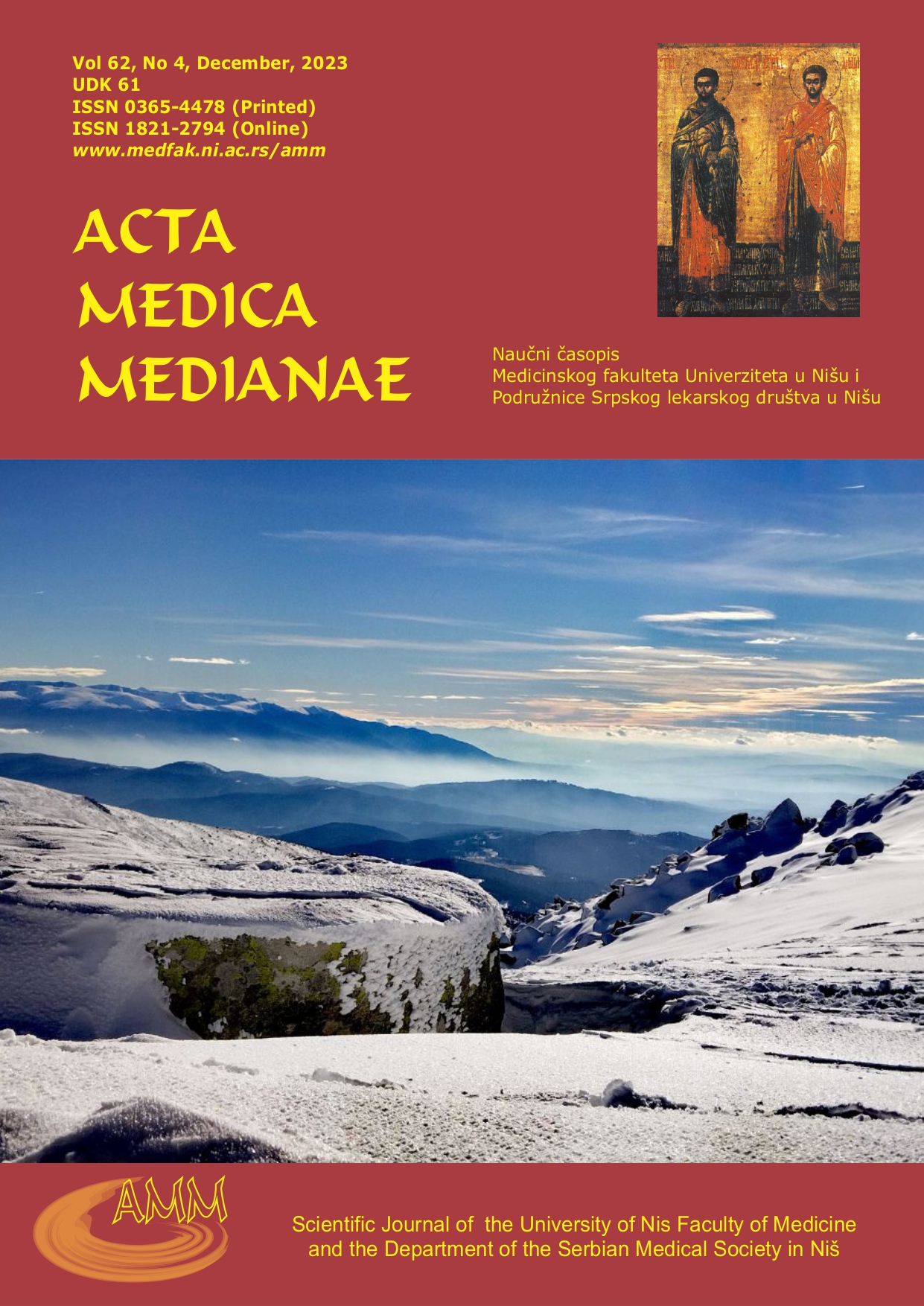PROCENA RIZIKA ZA POJAVU PSIHOZE KOD ADOLESCENATA U KLINIČKOJ PRAKSI
Sažetak
Važnost stanja povišenog rizika (engl. Ultra Hight Risk ‒ UHR) za pojavu psihoze prepoznata je do te mere da se sindrom atenuisane psihoze smatra novom dijagnostičkom kategorijom u DSM-5 klasifikaciji. Predloženi kriterijumi za sindrom atenuisane psihoze zahtevaju prisustvo najmanje jednog od triju pozitivnih psihotičnih simptoma (sumanutosti, halucinacije, dezorganizovanog govora) u oslabljenom obliku, ispoljenog najmanje jednom nedeljno u poslednjih mesec dana. Da bi se govorilo o sindromu atenuisane psihoze, potrebno je da je u poslednjih godinu dana došlo do pojave ili pogoršanja simptoma i da simptomi uzrokuju uznemirenost i onesposobljenost osobe koja ih doživljava, kao i traženje pomoći. Jedan od uslova za postavljanje ove dijagnoze jeste i nemogućnost boljeg objašnjenja navedenih simptoma nekim drugim (DSM-5) mentalnim poremećajem.
U radu je prikazana strukturirana procena sindroma atenuisane psihoze kod sedamnaestogodišnjeg adolescenta i diskutovano je o njegovom implikacijama u dijagnostici i tretmanu. Za procenu su, pored kliničkog pregleda, korišćene Sveobuhvatna procena rizičnog mentalnog stanja (engl. The Comprehensive Assessment of At-risk Mental States ‒ CAARMS, version 2006) i Skala procene društvenog i profesionalnog funkcionisanja (engl. The Social and Occupational Functioning Assessment Scale ‒ SOFAS).
Procena sindroma atenuisane psihoze, posebno u adolescenciji, delikatan je zadatak za stručnjake za mentalno zdravlje. Značajno je da ona daje mogućnost da se identifikuju visokorizične osobe, da se rano interveniše ciljanjem prisutnih simptoma, da se smanji stres, da se poboljša funkcionisanje i sprečila ili makar uspori progresija psihotičnih simptoma do jasno ispoljene kliničke slike psihoze.
Reference
Addington J, Devoe DJ, Santesteban-Echarri O. Multidisciplinary Treatment for Individuals at Clinical High Risk of Developing Psychosis. Curr Treat Options Psychiatry 2019;6(1):1-16. [CrossRef][PubMed]
Addington J, Epstein I, Liu L, French P, Boydell KM, Zipursky RB. A randomized controlled trial of cognitive behavioral therapy for individuals at clinical high risk of psychosis. Schizophr Res 2011;125(1):54-61. [CrossRef][PubMed]
Addington J, Stowkowy J, Liu L, Cadenhead KS, Cannon TD, Cornblatt BA et al. Clinical and functional characteristics of youth at clinical high-risk for psychosis who do not transition to psychosis. Psychol Med 2019; 49(10):1670-77. [CrossRef][PubMed]
American Psychiatric Association. Diagnostic and Statistical Manual of Mental Disorders, Fifth Edition. Washington, DC: American Psychiatric Association; 2013. [CrossRef]
Arango C. Attenuated psychotic symptoms syndrome: how it may affect child and adolescent psychiatry. Eur Child Adolesc Psychiatry 2011;20(2):67–70. [CrossRef][PubMed]
Bechdolf A, Wagner M, Ruhrmann S, Harrigan S, Putzfeld V, Pukrop R et al. Preventing progression to first-episode psychosis in early initial prodromal states. Br J Psychiatry 2012;200(1):22-9. [CrossRef][PubMed]
Cadenhead KS, Mirzakhanian H. A Case of Attenuated Psychosis Syndrome: A Broad Differential Diagnosis Requires Broad-Spectrum Treatment. Am J Psychiatry 2016;173(4):321-9. [CrossRef][PubMed]
Carrión RE, Auther AM, McLaughlin D, Olsen R, Addington J, Bearden CE et al. The global functioning: social and role scales-further validation in a large sample of adolescents and young adults at clinical high risk for psychosis. Schizophr Bull 2019;45(4):763–72. [CrossRef][PubMed]
Catalan A, Salazar de Pablo G, Vaquerizo Serrano J, Mosillo P, Baldwin H, Fernández-Rivas et al. Annual Research Review: Prevention of psychosis in adolescents - systematic review and meta-analysis of advances in detection, prognosis and intervention. J Child Psychol Psychiatry 2021;62(5):657-73. [CrossRef][PubMed]
Chow J, Kabani R, Lithgow K, Sarna MA. Yung AR, McGorry PD. The prodromal phase of first-episode psychosis: past and current conceptualizations. Schizophr Bull 1996;22(2):353-70. [CrossRef][PubMed]
Fusar-Poli P, Bonoldi I, Yung AR, Borgwardt S, Kempton MJ, Valmaggia L. et al. Predicting psychosis: meta-analysis of transition outcomes in individuals at high clinical risk. Arch Gen Psychiatry 2012;69(3):220-9. [CrossRef][PubMed]
Fusar-Poli P, Borgwardt S, Bechdolf A, Addington J, Riecher-Rössler A, Schultze-Lutter F, et al. The psychosis high-risk state: a comprehensive state-of-the-art review. JAMA Psychiatry 2013;70(1):107-20. [CrossRef][PubMed]
Fusar-Poli P, Rocchetti M, Sardella A, Avila A, Brandizzi M, Caverzasi E. et al. Disorder, not just state of risk: meta-analysis of functioning and quality of life in people at high risk of psychosis. Br J Psychiatry 2015;207(3):198-206. [CrossRef][PubMed]
Fusar-Poli P, Salazar de Pablo G, Correll CU, Meyer-Lindenberg A, Millan MJ, Borgwardt S et al. Prevention of Psychosis: advances in detection, prognosis, and intervention. JAMA Psychiatry 2020;77(7):755-65. [CrossRef][PubMed]
Koutsouleris N, Kambeitz-Ilankovic L, Ruhrmann S, Rosen M, Ruef A, Dwyer DB et al. Prediction models of functional outcomes for individuals in the clinical high-risk state for psychosis or with recent-onset depression: a multimodal, multisite machine learning analysis. JAMA Psychiatry 2018;75(11):1156–72. [CrossRef][PubMed]
Kraan T, Velthorst E, Smit F, de Haan L, van der Gaag M. Trauma and recent life events in individuals at ultra high risk for psychosis: review and meta-analysis. Schizophr Res 2015;161(2-3):143-9. [CrossRef][PubMed]
Miller TJ, McGlashan TH, Rosen JL, Cadenhead K, Cannon T, Ventura J. et al. Prodromal assessment with the structured interview for prodromal syndromes and the scale of prodromal symptoms: predictive validity, interrater reliability, and training to reliability. Schizophr Bull 2003; 29(4):703-15. [CrossRef][PubMed]
Miller TJ, McGlashan TH, Woods SW, Stein K, Driesen N, Corcoran CM, et al. Symptom assessment in schizophrenic prodromal states. Psychiatr Q 1999;70(4):273-87. [CrossRef][PubMed]
Poletti M, Pelizza L, Azzali S, Paterlini F, Garlassi S, Scazza I et al. Clinical high risk for psychosis in childhood and adolescence: findings from the 2-year follow-up of the ReARMS project. Eur Child Adolesc Psychiatry 2019:28(7):957-71. [CrossRef][PubMed]
Schmidt SJ, Schultze‐Lutter F, Schimmelmann BG, Maric NP, Salokangas RK, Riecher‐Rossler A et al. EPA guidance on the early intervention in clinical high risk states of psychoses. Eur Psychiatry 2015;30(3):388–04. [CrossRef][PubMed]
Taylor PJ, Hutton P, Wood L. Are people at risk of psychosis also at risk of suicide and self-harm? A systematic review and meta-analysis. Psychol Med 2015;45(5):911- 26. [CrossRef][PubMed]
Yung AR, Yuen HP, McGorry PD, Phillips LJ, Kelly D, Dell'Olio M et al. Mapping the onset of psychosis: the comprehensive assessment of at-risk mental states. Aust N Z J Psychiatry 2005; 39(11-12):964–71. [CrossRef][PubMed]
Ziermans TB, Schothorst PF, Sprong M, van Engeland H. Transition and remission in adolescents at ultra-high risk for psychosis. Schizophr Res 2011;126:58–64. [CrossRef][PubMed]

